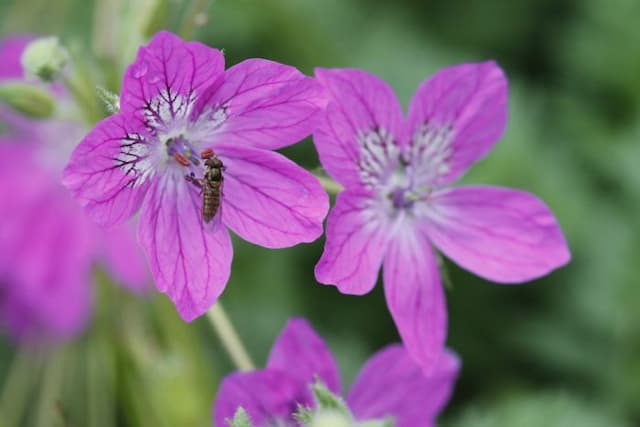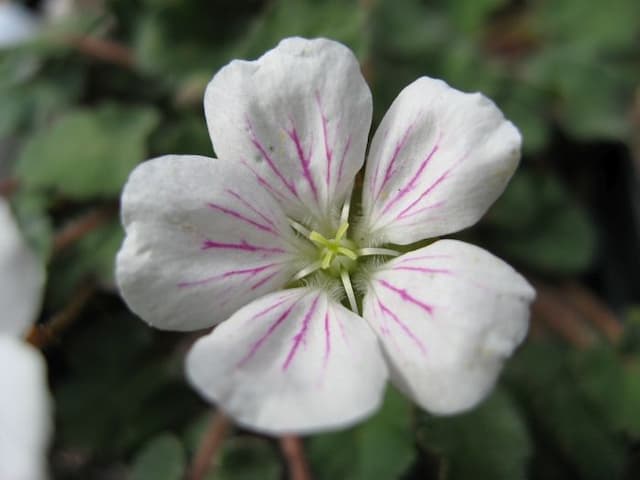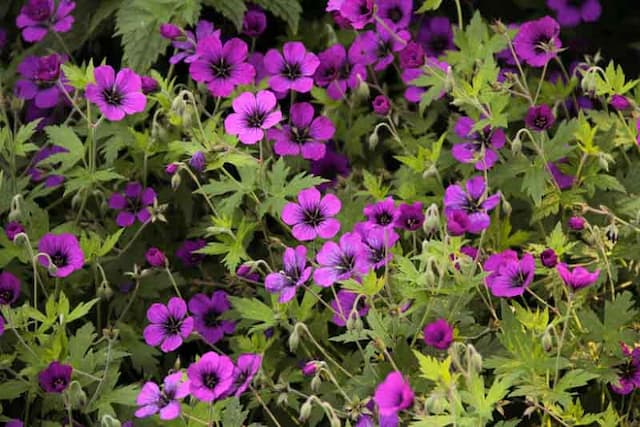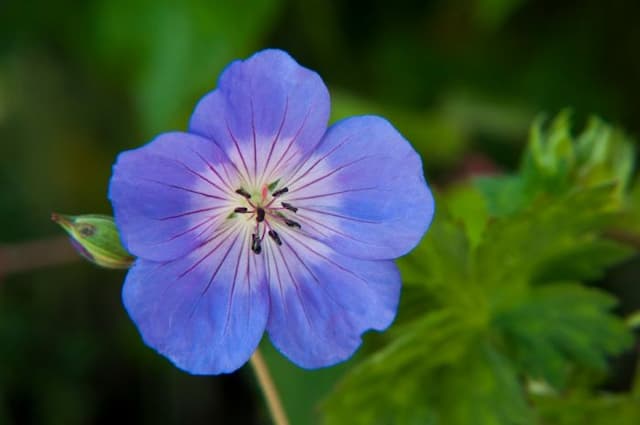Grey-leaved cranesbill Geranium subcaulescens

ABOUT
Geranium subcaulescens, commonly known as the grey cranesbill, is a herbaceous plant known for its decorative appearance. It showcases a lush mound of deeply lobed, slightly ruffled leaves that are soft to the touch, providing a textural backdrop for the flowers. These leaves often have a greyish-green hue that can be quite striking in contrast to the brighter aspects of a garden. The impressive aspect of the grey cranesbill is its vibrant, magenta-pink flowers. Each flower consists of five rounded petals that come together in a way that resembles the classic cranesbill shape. The center of the flower is often marked with a pattern of darker veins, which converge to form a striking, eye-catching display. These veins act as nectar guides, leading pollinators to the center of the bloom. With the change of seasons, the grey cranesbill also presents a shift in color. The leaves can develop reddish tones, adding to the plant's ornamental value. Both the flowers and the foliage contribute to a rich display of color and form, making Geranium subcaulescens a favored choice for gardeners looking to add long-lasting interest to their garden beds or borders.
About this plant
 Names
NamesFamily
Geraniaceae
Synonyms
Grey Leaf Geranium
Common names
Geranium subcaulescens.
 Toxicity
ToxicityTo humans
Geranium subcaulescens, commonly known as grey-leaved cistern rose, is not typically considered to be toxic to humans. However, as with many plants, individual sensitivities can vary, and it is generally advisable to avoid ingesting plants that are not known to be edible. There is not much documented evidence of serious toxicity in humans related to the ingestion of this particular geranium species. In the case of accidental ingestion, it is recommended to consult a medical professional for advice.
To pets
Grey-leaved cistern rose is also considered to be non-toxic to pets. This includes typical household pets like dogs and cats. As with humans, individual animals may have allergies or sensitivities, so it is always a good idea to prevent pets from ingesting plants not intended for consumption. In general, the Geranium subcaulescens does not pose a significant risk of toxicity to pets. If a pet does ingest some of this plant and experiences adverse effects, it is best to contact a veterinarian.
 Characteristics
CharacteristicsLife cycle
Perennials
Foliage type
Deciduous
Color of leaves
Green
Flower color
Pink
Height
0.5 feet (15 cm)
Spread
1 feet (30 cm)
Plant type
Herb
Hardiness zones
8
Native area
Mediterranean
Benefits
 General Benefits
General Benefits- Ornamental appeal: Geranium subcaulescens, commonly known as Grey-leaved Cranesbill, offers vibrant flowers and attractive foliage adding aesthetic value to gardens and landscapes.
- Drought tolerance: This plant is known for its ability to withstand dry conditions, making it suitable for xeriscaping and water-efficient gardening.
- Low maintenance: Grey-leaved Cranesbill requires minimal care once established, making it a convenient choice for gardeners of all skill levels.
- Pest resistance: It's generally resistant to pests, reducing the need for chemical treatments and fostering a more natural garden environment.
- Habitat support: The flowers provide nectar for pollinators such as bees and butterflies, supporting local ecosystems.
- Ground cover: With its spreading habit, it can be used effectively as ground cover, helping to suppress weeds and stabilize soil.
- Seasonal interest: Grey-leaved Cranesbill offers seasonal interest with its changing foliage colors in the fall, adding variety to the garden throughout the year.
 Medical Properties
Medical Properties- This plant is not used for medical purposes.
 Air-purifying Qualities
Air-purifying QualitiesThis plant is not specifically known for air purifying qualities.
 Other Uses
Other Uses- Geranium subcaulescens can be used as a natural dye for fabrics, producing a range of colors from green to brown depending on the mordant used.
- In a garden setting, Geranium subcaulescens can function as a ground cover, preventing soil erosion and outcompeting weeds.
- This plant's aromatic leaves can be placed in closets or drawers as a natural moth repellent, keeping clothes free from harm.
- The petals of Geranium subcaulescens can be used in culinary presentations, as an edible decoration for salads and desserts, though they are not widely known for their flavor.
- Extracts from the plant are sometimes used in perfumery, to create a subtle, floral scent characteristic of the geranium family.
- Geranium subcaulescens can be cultivated for educational purposes in botanical studies, serving as an example of hardy, rock garden plant species.
- In art, the vibrant pigment of the petals can be used to create natural inks for painting or fabric art projects.
- Due to its drought-resistant nature, the plant can play a role in xeriscaping, contributing to water conservation in landscape design.
- The leaves of Geranium subcaulescens can be infused in water to create a flavored bath experience, with potential relaxing effects due to its fragrance.
- The dense, mat-forming habit of this geranium makes it an excellent choice for green roofing projects, helping to insulate buildings and promote biodiversity.
Interesting Facts
 Feng Shui
Feng ShuiThe Geranium is known in Feng Shui to promote positive energy, and it's often used for enhancing relationships and healing. Placing geraniums in your love and marriage area, usually in the southwest corner of your garden, home, or room, can help foster a stronger and more loving relationship with your partner.
 Zodiac Sign Compitability
Zodiac Sign CompitabilityThe Geranium is not used in astrology practice.
 Plant Symbolism
Plant Symbolism- Unity and True Friendship: Geraniums are often associated with positive relationships and bonds between friends, symbolizing a strong connection.
- Good Health: The geranium plant has been used in traditional medicine, leading to its symbolism of health and vitality.
- Fertility and New Life: Because they are flowering plants, geraniums can represent fertility and the creation of new life.
- Happiness and Positive Emotions: The bright and colorful flowers of the geranium are symbolic of happiness and a positive outlook on life.
- Protection: In folk traditions, geraniums are sometimes used to ward off evil spirits, representing protection.
 Water
WaterGrey-leaf geranium needs moderate watering, ensuring the top inch of soil dries out between watering sessions to prevent root rot. Aim to water approximately once a week; however, adjust the frequency according to weather conditions and indoor climate. Use about 16 ounces of water for smaller pots each time you water, and up to a gallon for larger containers, distributing it evenly around the base of the plant, making sure not to waterlog the soil.
 Light
LightGrey-leaf geranium thrives best in full sun to partial shade conditions. An ideal spot would be a south or west-facing window if grown indoors, or a garden spot that receives at least 4 to 6 hours of sunlight daily. Avoid placing it in deep shade as this can impede blooming and overall vitality of the plant.
 Temperature
TemperatureGrey-leaf geranium prefers temperatures between 65 and 75 degrees Fahrenheit but can withstand dips down to 50 degrees. It should not be exposed to temperatures below freezing point as it is not frost-tolerant. During hot summer days, make sure the plant is not subject to temperatures exceeding 85 degrees for extended periods, which could stress the plant.
 Pruning
PruningPrune grey-leaf geranium to maintain its shape and encourage bushier growth, as well as to remove any dead or yellowing leaves. The best time to prune is late winter or early spring before new growth begins. Pruning can be done every couple of months or as needed to keep the plant tidy.
 Cleaning
CleaningAs needed
 Soil
SoilGrey Cranesbill (Geranium subcaulescens) thrives in a soil mix with good drainage, composed of loamy soil, peat, and sharp sand or perlite in equal parts. The ideal soil pH for Grey Cranesbill should be slightly acidic to neutral, ranging between 5.8 and 7.0.
 Repotting
RepottingGrey Cranesbill should be repotted every 2-3 years or when it outgrows its current container. It's best to repot in the spring just before the active growth period.
 Humidity & Misting
Humidity & MistingGrey Cranesbill prefers moderate humidity levels but is quite adaptable and can tolerate the lower humidity levels typically found in home environments.
 Suitable locations
Suitable locationsIndoor
Provide bright light, moderate water, and well-draining soil.
Outdoor
Plant in well-drained soil and full sun to part shade.
Hardiness zone
5-8 USDA
 Life cycle
Life cycleGeranium subcaulescens, commonly known as the Grey Cranesbill or Hardy Geranium, begins its life cycle with seed germination, when the plant breaks dormancy and emerges from the soil typically in spring. The seedling stage is followed by the development of a rosette of basal leaves, which are often heart-shaped and sometimes have a reddish tinge. As it matures, the plant enters the vegetative stage, producing more leaves and stems, and then reaches the flowering stage, where it develops distinctive pink to purplish flowers with veined petals. After pollination, typically by insects, the flowers produce beaked seed capsules, which give rise to the common name "cranesbill." Seeds are dispersed by a mechanism called explosive dehiscence, where the mature fruit capsule flings seeds away from the parent plant. Finally, the plant enters a period of dormancy during the colder months, completing its annual or perennial cycle depending on the climate and growing conditions.
 Propogation
PropogationPropogation time
Spring-summer
The Geranium subcaulescens, commonly known as the Grayleaf Cranesbill, is typically propagated by seed or by division. The most popular method is by division, which can be done in spring or autumn. To propagate by division, carefully lift the parent plant from the ground with a shovel, ensuring a good amount of root and soil is attached. Using a sharp knife or spade, divide the clump into smaller pieces, each with several shoots and a healthy root system. Replant the divisions at the same depth they were growing previously, spacing them about 12 inches (approximately 30 centimeters) apart to allow for adequate growth. Water the new plants thoroughly after planting to help establish them. This method is effective because it maintains the characteristics of the parent plant and allows for quick establishment in the garden.








![Cranesbill [Rothbury Gem]](/_next/image?url=https%3A%2F%2Fplants-admin.emdemapps.com%2Fimages%2Fplants%2F%2Fimages%2F604b6243984c2.png&w=640&q=75)
